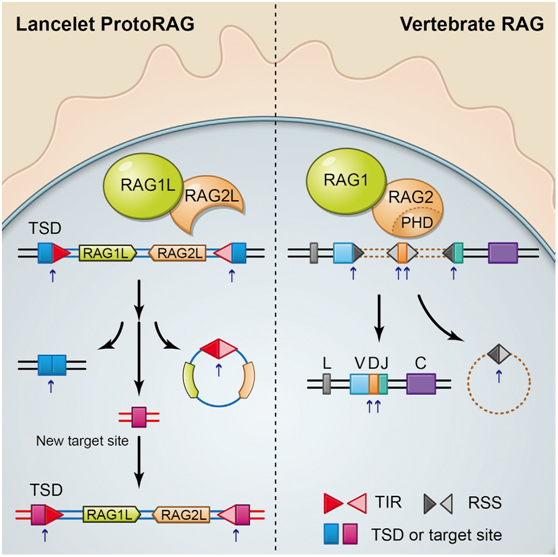Prof. Anlong Xu's team reported the discovery of the long-sought RAG transposon in Cell
Source:Anlong Xu
2016-07-12
On June 30, 2016, Professor Anlong Xu and his colleagues from Sun Yat-Sen University published their findings "Discovery of an Active RAG Transposon Illuminates the Origins of V(D)J Recombination." (Cell, 2016,166:102-114) in the international first-class academic journal "Cell". They reported the discovery of the long-sought RAG transposon from a basal chordate called lancelet or amphioxus. This work provides the strongest evidence supporting the transposon hypothesis that has been used to explain the origins of the V(D)J rearrangement for the human B/T-cell receptors in the last four decades. Dr. Xu is the corresponding author, while his three colleagues, Dr. Shengfeng Huang, Dr. Xin Tao, and Dr. Shaochun Yuan are the co-first authors.
In late 1970s, Nobel Prize laureate Susumu Tonegawa proposed the transposon hypothesis to explain the origins of the V(D)J rearrangement for the human B/T-cell receptors (Sakano et al., 1979). Later, the host gene pair of RAG1 and RAG2 responsible for the V(D)J rearrangement have been discovered by David Schatz and colleagues (Oettinger et al., 1990; Schatz et al., 1989). Since then, the host domestication of a RAG transposon is considered a milestone event in the genesis of the adaptive immune system in jawed vertebrates (Flajnik and Kasahara, 2010). However, despite huge efforts made during the last nearly four decades, there is no solid evidence to support the hypothesis. Indeed, the legendary “RAG transposon” has long been considered lost several hundred million years ago.
In the latest issue of Cell, Dr. Anlong Xu and his colleagues report the discovery of ProtoRAG, a novel DNA transposon family from lancelets, the most basal extant chordate. A typical ProtoRAG is flanked by 5 bp target site duplications (TSDs) and a pair of terminal inverted repeats (TIRs) resembling the V(D)J recombination signal sequences. The tail-to-tail oriented and intron-containing RAG1-like and RAG2-like genes are located between the TIRs. They demonstrate that ProtoRAG was transcribed in the lancelet germline and that the lancelet RAG1/2-like proteins can mediate TIR-dependent transposon excision, host DNA recombination, transposition, and even low-frequency TIR-to-TIR rejoining using the molecular mechanisms similar to those used by human RAG. These data show that ProtoRAG represents a molecular "living fossil” of the long-sought RAG transposon, and provide powerful evidence in favor of the RAG transposon hypothesis for the origins of jawed vertebrate adaptive immunity.

The paper links:http://www.cell.com/cell/fulltext/S0092-8674(16)30583-9
Shengfeng Huang, Xin Tao, Shaochun Yuan, Yuhang Zhang, Peiyi Li, Helen A. Beilinson, Ya Zhang, Wenjuan Yu, Pierre Pontarotti, Hector Escriva, Yann Le Petillon, Xiaolong Liu, Shangwu Chen, David G. Schatz, Anlong Xu. Discovery of an Active RAG Transposon Illuminates the Origins of V(D)J Recombination. Cell. 2016 Jun 30;166(1):102-14.
Leading Edge Preview on the same journal links:http://www.cell.com/cell/fulltext/S0092-8674(16)30789-9
In late 1970s, Nobel Prize laureate Susumu Tonegawa proposed the transposon hypothesis to explain the origins of the V(D)J rearrangement for the human B/T-cell receptors (Sakano et al., 1979). Later, the host gene pair of RAG1 and RAG2 responsible for the V(D)J rearrangement have been discovered by David Schatz and colleagues (Oettinger et al., 1990; Schatz et al., 1989). Since then, the host domestication of a RAG transposon is considered a milestone event in the genesis of the adaptive immune system in jawed vertebrates (Flajnik and Kasahara, 2010). However, despite huge efforts made during the last nearly four decades, there is no solid evidence to support the hypothesis. Indeed, the legendary “RAG transposon” has long been considered lost several hundred million years ago.
In the latest issue of Cell, Dr. Anlong Xu and his colleagues report the discovery of ProtoRAG, a novel DNA transposon family from lancelets, the most basal extant chordate. A typical ProtoRAG is flanked by 5 bp target site duplications (TSDs) and a pair of terminal inverted repeats (TIRs) resembling the V(D)J recombination signal sequences. The tail-to-tail oriented and intron-containing RAG1-like and RAG2-like genes are located between the TIRs. They demonstrate that ProtoRAG was transcribed in the lancelet germline and that the lancelet RAG1/2-like proteins can mediate TIR-dependent transposon excision, host DNA recombination, transposition, and even low-frequency TIR-to-TIR rejoining using the molecular mechanisms similar to those used by human RAG. These data show that ProtoRAG represents a molecular "living fossil” of the long-sought RAG transposon, and provide powerful evidence in favor of the RAG transposon hypothesis for the origins of jawed vertebrate adaptive immunity.

Graphic abstract: A family of DNA transposons discovered in fish-like marine chordates may hold the key for the evolution of adaptive immunity in higher organisms
The paper links:http://www.cell.com/cell/fulltext/S0092-8674(16)30583-9
Shengfeng Huang, Xin Tao, Shaochun Yuan, Yuhang Zhang, Peiyi Li, Helen A. Beilinson, Ya Zhang, Wenjuan Yu, Pierre Pontarotti, Hector Escriva, Yann Le Petillon, Xiaolong Liu, Shangwu Chen, David G. Schatz, Anlong Xu. Discovery of an Active RAG Transposon Illuminates the Origins of V(D)J Recombination. Cell. 2016 Jun 30;166(1):102-14.
Leading Edge Preview on the same journal links:http://www.cell.com/cell/fulltext/S0092-8674(16)30789-9


